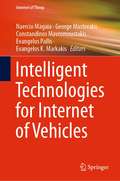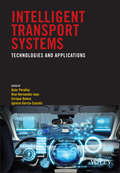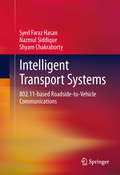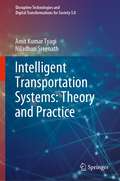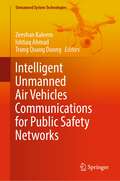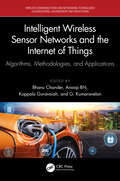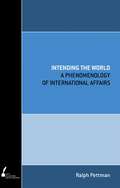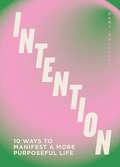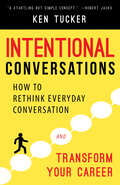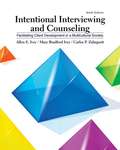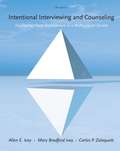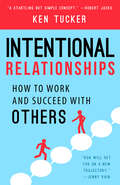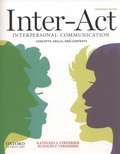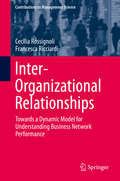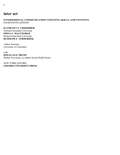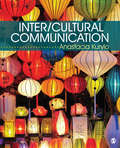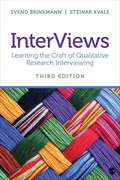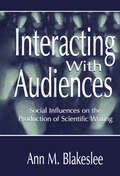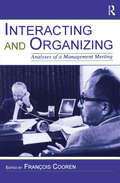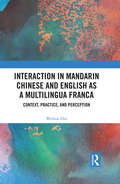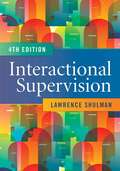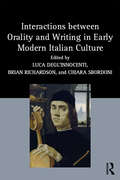- Table View
- List View
Intelligent Technologies for Internet of Vehicles (Internet of Things)
by George Mastorakis Evangelos Pallis Naercio Magaia Constandinos Mavromoustakis Evangelos K. MarkakisThis book gathers recent research works in emerging Artificial Intelligence (AI) methods for the convergence of communication, caching, control, and computing resources in cloud-based Internet of Vehicles (IoV) infrastructures. In this context, the book's major subjects cover the analysis and the development of AI-powered mechanisms in future IoV applications and architectures. It addresses the major new technological developments in the field and reflects current research trends and industry needs. It comprises a good balance between theoretical and practical issues, covering case studies, experience and evaluation reports, and best practices in utilizing AI applications in IoV networks. It also provides technical/scientific information about various aspects of AI technologies, ranging from basic concepts to research-grade material, including future directions. This book is intended for researchers, practitioners, engineers, and scientists involved in designing and developing protocols and AI applications and services for IoV-related devices.
Intelligent Transport Systems
by Enrique Onieva Unai Hernandez-Jayo Asier Perallos Ignacio Julio García ZuazolaThe book provides a systematic overview of Intelligent Transportation Systems (ITS). First, it includes an insight into the reference architectures developed within the main EU research projects. Then, it delves into each of the layers of such architectures, from physical to application layer, describing the technological issues which are being currently faced by some of the most important ITS research groups. The book concludes with some end user services and applications deployed by industrial partners. This book is a well-balanced combination of academic contributions and industrial applications in the field of Intelligent Transportation Systems. The most representative technologies and research results achieved by some of the most relevant research groups working on ITS, collated to show the chances of generating industrial solutions to be deployed in real transportation environments.
Intelligent Transport Systems
by Nazmul Siddique Shyam Chakraborty Syed Faraz HasanFocusing on the nuts and bolts of wireless network access for computers on board vehicles, this volume shows how in-car computerization now does much more than merely act as a glorified map-reader. Wireless communication is transforming road travel in ways previously undreamt of, allowing vehicles to "talk" to a wider network and monitor road conditions, potential delays and traffic congestion, all automatically. Toll payments can be made without opening the driver's window on a cold day, while vehicles might themselves take active steps to avoid collisions. It is the connection between on-board computers and wireless access points, ubiquitous in most cities now, that is a key area of research. Moving vehicles transfer their communications to new points as they progress, and this causes delays, known as "handover latency". In this book, new stochastic models are developed to map the disruption when connecting to 802.11 WLAN points. It details the application of stochastic tools to analyzing communication networks, as well as previous literature on handover latency and relevant mathematical modeling. Finally, it presents a scheme for monitoring traffic congestion using WLAN connectivity. This volume will be a useful addition to the libraries both of wireless communication students and those studying probability theory.
Intelligent Transportation Systems: Theory and Practice (Disruptive Technologies and Digital Transformations for Society 5.0)
by Amit Kumar Tyagi Niladhuri SreenathThis book provides fundamental principles of intelligent transport systems with comprehensive insight and state of the art of vehicles, vehicular technology, connecting vehicles, and intelligent vehicles/autonomous intelligent vehicles. The book discusses different approaches for multiple sensor-based multiple-objects tracking, in addition to blockchain-based solutions for building tamper-proof sensing devices. It introduces various algorithms for security, privacy, and trust for intelligent vehicles. This book countermeasures all the drawbacks and provides useful information to students, researchers, and scientific communities. It contains chapters from national and international experts and will be essential for researchers and advanced students from academia, and industry experts who are working on intelligent transportation systems.
Intelligent Unmanned Air Vehicles Communications for Public Safety Networks (Unmanned System Technologies)
by Ishtiaq Ahmad Trung Quang Duong Zeeshan KaleemThis book provides a comprehensive overview of the potential use cases and intelligent technologies, UAV layered architectures, research findings, experimental results, and standardization for intelligent UAV communications for public safety networks. This book will cover the conventional non-intelligent and intelligent solutions specifically targeting UAV communications for public safety networks. Moreover, reconfigurable intelligent surface (RIS) has recently attracted researchers and academician attention because its ability improves the propagation environment and enhances communication quality by intelligently reflecting the received signals. Leveraging intelligence into RIS-assisted UAV communications will meet the requirements of the intelligent, green, and sustainable 5G and beyond cellular networks, which makes it a potential candidate to overcome the inherent drawbacks of legacy wireless systems.The topics covered in this book will be of interest to both the professionals and students. 3D UAV placements schemes, trajectory design, interference management schemes, reinforcement learning solutions for more intelligent and trained solutions, joint UAV trajectory and RIS's passive beamforming design, and various other related topics of readers' interest are presented in detail.
Intelligent Wireless Sensor Networks and the Internet of Things: Algorithms, Methodologies, and Applications (Wireless Communications and Networking Technologies)
by Bhanu Chander Koppala Guravaiah G. Kumaravelan Anoop BnThe edited book Intelligent Wireless Sensor Networks and Internet of Things: Algorithms, Methodologies and Applications is intended to discuss the progression of recent as well as future generation technologies for WSNs and IoTs applications through Artificial Intelligence (AI), Machine Learning (ML), and Deep Learning (DL). In general, computing time is obviously increased when the massive data is required from sensor nodes in WSN’s. the novel technologies such as 5G and 6G provides enough bandwidth for large data transmissions, however, unbalanced links faces the novel constraints on the geographical topology of the sensor networks. Above and beyond, data transmission congestion and data queue still happen in the WSNs.This book: Addresses the complete functional framework workflow in WSN and IoT domains using AI, ML, and DL models Explores basic and high-level concepts of WSN security, and routing protocols, thus serving as a manual for those in the research field as the beginners to understand both basic and advanced aspects sensors, IoT with ML & DL applications in real-world related technology Based on the latest technologies such as 5G, 6G and covering the major challenges, issues, and advances of protocols, and applications in wireless system Explores intelligent route discovering, identification of research problems and its implications to the real world Explains concepts of IoT communication protocols, intelligent sensors, statistics and exploratory data analytics, computational intelligence, machine learning, and Deep learning algorithms for betterment of the smarter humanity Explores intelligent data processing, deep learning frameworks, and multi-agent systems in IoT-enabled WSN system This book demonstrates and discovers the objectives, goals, challenges, and related solutions in advanced AI, ML, and DL approaches This book is for graduate students and academic researchers in the fields of electrical engineering, electronics and communication engineering, computer engineering, and information technology.
Intending the World: A Phenomenology of International Affairs
by Ralph PettmanHow we look at the world is informed mainly by our assumptions and the ways in which we rationalise them. Seldom do we rely—or allow ourselves to rely—on 'gut thinking' or intuition.Intending the World shows how rationalism, which is our primary approach in thinking about world affairs, is in crisis. By studying the world rationalistically, we objectify it and we look at it as detached from ourselves. But in doing so, we cease to see that we are using a perspective that limits as well as enlightens.In a disciplinary first, Ralph Pettman provides an account of twenty-first century international relations in terms of phenomenology—one of the main philosophical attempts to compensate for these limits. He explores how this re-embedded use of reason can successfully describe and explain world affairs in ways unused by rationalists.Intending the World follows the lead of the German philosopher Edmund Husserl. It looks at the world not only in terms of things-in-themselves, but also in terms of why it is we keep willing the world the way we do.
Intention: 10 ways to live purposefully
by Dani SullivanSimplify your life.Manifest your desires.Live with intention.Are you ready to live more purposefully?Live each day with foresight, concentrating on your goals and the tangible steps you can take to reach them. Through quick, constructive exercises, inspirational quotes, journaling activities and reflective practices, this ten-step programme is the perfect guide to living with clarity.
Intention: 10 ways to live purposefully
by Dani SullivanSimplify your life.Manifest your desires.Live with intention.Are you ready to live more purposefully?Live each day with foresight, concentrating on your goals and the tangible steps you can take to reach them. Through quick, constructive exercises, inspirational quotes, journaling activities and reflective practices, this ten-step programme is the perfect guide to living with clarity.
Intentional Conversations: How to Rethink Everyday Conversation and Transform Your Career
by Ken TuckerUsing six steps and a "SECRET" formula, international speaker, Fortune 500 strategist, and bestselling management author Ken Tucker explores the challenging skill sets required to navigate conflict and crucial conversations effectively. Drawing upon decades of experience in the corporate and government worlds, Tucker teaches leaders how to say what they really need to say and say it right so that their people and organizations execute the results they want and need. Intentional Conversations includes:Context and conversations that lead to good results and those that don't.How leaders can use the "SECRET" process to enhance their success at work and in life.Creative sidebars and QR media links that illustrate the principles in the book.
Intentional Interviewing And Counseling: Facilitating Client Development In A Multicultural Society
by Allen E. Ivey Mary Bradford Ivey Carlos P. ZalaquettMaster interviewing skills with INTENTIONAL INTERVIEWING AND COUNSELING: FACILITATING CLIENT DEVELOPMENT IN A MULTICULTURAL SOCIETY, 9th Edition. This textbook gives you the tools to adapt your skills to address both individual and multicultural uniqueness, conduct interviews using five different theoretical approaches, and begin developing a personalized style and theory of interviewing and counseling that matches your own aptitudes and affinities. Moreover, this is the only text in the field that will show you how to understand and use neuroscience in counseling practice. Case studies, sample interviews, and a "Portfolio of Competencies" are just a few of the many tools that will help you master the material and become a better listener.
Intentional Interviewing and Counseling: Facilitating Client Development in a Multicultural Society, 8th Edition
by Allen E. Ivey Mary Bradford Ivey Carlos P. ZalaquettMaster interviewing skills with INTENTIONAL INTERVIEWING AND COUNSELING: FACILITATING CLIENT DEVELOPMENT IN A MULTICULTURAL SOCIETY, 8th Edition. This book gives you the tools to adapt your skills to address both individual and multicultural uniqueness, conduct interviews using five different theoretical approaches, and begin developing a personalized style and theory of interviewing and counseling that matches your own aptitudes and affinities. Case studies, sample interviews, and a "Portfolio of Competencies" are just a few of the many tools that will help you master the material and become a better listener. Available with InfoTrac Student Collections http://gocengage. com/infotrac.
Intentional Relationships: How to Work and Succeed with Others
by Ken TuckerEvery day, our actions are structured by our relationships. Whether it be through family ties, a shared workspace, a favorite hobby, or some other repeated interaction, we are constantly building relationships. But do we ever stop to consider why we are in a relationship with a particular person? How can we make important relationships stronger? And how can we avoid unhealthy relationships? From Fortune 500 consultant Ken Tucker, Intentional Relationships answers these questions and more in a surprising, life-changing, and career-enhancing way. Recognize and celebrate the most valuable connections in your life by practicing Intentional Relationships.
Inter-Act: Interpersonal Communication Concepts, Skills, and Contexts (Thirteenth Edition)
by Rudolph F. Verderber Kathleen S. VerderberDesigned to help students understand communication processes in relationships and develop specific skills needed to create and maintain healthy ones, Inter-Act: Interpersonal Communication Concepts, Skills, and Contexts, Thirteenth Edition, retains the features that have made this book so successful: a theory driven skills-based focus, an accessible tone and presentation, and a multitude of useful pedagogical tools. For this edition, Joseph Mazer of Clemson University (whose scholarship includes original research on social media) authored much of the new and unique social media content and Brant Burleson and Erina MacGeorge of Purdue helped to update the scholarship, while maintaining the skills-based approach that this text is known for. Lively and well-written, Inter-Act features numerous activities that enable students to relate their everyday experiences to their studies in communication. It also clearly illustrates how cultural, racial, and gender differences-as well as electronically mediated messages-alter what we should do to communicate effectively. With a strong focus on the importance of ethics, this leading text encourages students to develop their analytical abilities as they think critically about key concepts in interpersonal communication.
Inter-Organizational Relationships
by Cecilia Rossignoli Francesca RicciardiThis book explores the premise that organizations are significantly influenced by their inter-organizational relationships; moreover, these relationships may generate important externalities, both positive and negative, impacting the environment at several levels. The advent of the Internet era, on the other hand, has resulted in disruptive changes in traditional inter-organizational networks, and some completely new inter-organizational settings are now arising. In its first part the book reviews the most commonly cited theories explaining inter-organizational phenomena: transaction costs economics, agency theory, resource dependence theory, game theories, collaborative networks theory, institutional theories, organizational ecology, resource-based / relational-based view of the firm, and knowledge network / social network theories. In Part II it thoroughly reviews the literature on a number of key IT-enabled inter-organizational systems currently on the rise, such as virtual organizations, e-intermediators and e-marketplaces. Lastly, Part III presents the case of the Yoox Group, a leading firm offering e-commerce services for fashion and design products. A framework is proposed for systematically linking the different possible types of inter-organizational relationships to specific, suitable sets of theories. The range of possible inter-organizational relationships is described on the basis of three pairs of opposites: conformism-breach, exploitation-exploration, and cooperation-competition. This results in a model that makes it possible to combine different theories in order to study the effects of inter-organizational ambidexterity and dynamism on performance.
Inter-act: Interpersonal Communication: Concepts, Skills, and Contexts
by Kathleen S. Verderber Erina L. MacGeorgeDesigned to help students explore interactions in both personal and professional domains, and develop the specific skills necessary to creating and maintaining healthy relationships, Inter-Act: Interpersonal Communication Concepts, Skills, and Contexts, Fourteenth Edition, retains the features that have made this book so successful: a theory driven and skills-based focus, an accessible tone and presentation, and a multitude of useful pedagogical tools. For this edition, new coauthor Erina MacGeorge has brought her in-depth knowledge of current theory to bear on each chapter, thoroughly updating the material so that it reflects the current state of knowledge in the discipline.
Inter/Cultural Communication: Representation and Construction of Culture
by Anastacia KuryloToday, students are more familiar with other cultures than ever before because of the media, Internet, local diversity, and their own travels abroad. As such, traditional intercultural communication textbooks which focus solely on the ′differences′ approach aren′t truly effective for today′s students, nor for this field′s growth. Using a social constructionist framework—which explores how culture is constructed and produced in the moments in which it is experienced—Inter/Cultural Communication provides today′s students with a rich understanding of how culture and communication affect and effect each other.Inter/Cultural Communication improves upon current textbooks in four significant ways: (1) It provides a differences approach and a social constructionist approach; (2) It explores the consequences of cultural moments on immediate communication and on larger scale social issues; (3) It is descriptive, not prescriptive, of how culture is communicated; and (4) It introduces intercultural topics, rather than interpersonal topics. Weaving multiple approaches together in order to provide students with a comprehensive understanding of and appreciation for the diversity of cultural and intercultural communication, this text allows them to become more aware of their own identities and how powerful those identities can be in facilitating change—both in their own lives and in the lives of others. In addition, the book will help students deal with unfamiliar cultures and understand those with whom they come in contact when they travel, in their communities, in the workplace, in their home, and online.
Inter/Cultural Communication: Representation and Construction of Culture
by Anastacia KuryloToday, students are more familiar with other cultures than ever before because of the media, Internet, local diversity, and their own travels abroad. As such, traditional intercultural communication textbooks which focus solely on the ′differences′ approach aren′t truly effective for today′s students, nor for this field′s growth. Using a social constructionist framework—which explores how culture is constructed and produced in the moments in which it is experienced—Inter/Cultural Communication provides today′s students with a rich understanding of how culture and communication affect and effect each other.Inter/Cultural Communication improves upon current textbooks in four significant ways: (1) It provides a differences approach and a social constructionist approach; (2) It explores the consequences of cultural moments on immediate communication and on larger scale social issues; (3) It is descriptive, not prescriptive, of how culture is communicated; and (4) It introduces intercultural topics, rather than interpersonal topics. Weaving multiple approaches together in order to provide students with a comprehensive understanding of and appreciation for the diversity of cultural and intercultural communication, this text allows them to become more aware of their own identities and how powerful those identities can be in facilitating change—both in their own lives and in the lives of others. In addition, the book will help students deal with unfamiliar cultures and understand those with whom they come in contact when they travel, in their communities, in the workplace, in their home, and online.
InterViews: Learning the Craft of Qualitative Research Interviewing
by Steinar Kvale Svend BrinkmannThe Third Edition of Brinkmann and Kvale’s InterViews: Learning the Craft of Qualitative Research Interviewing, offers readers comprehensive and practical insight into the many factors that contribute to successful interviews. The book invites readers on a journey through the landscape of interview research, providing the "hows" and "whys" of research interviewing, and outlines paths for students to follow on the way to research goals. Thoroughly updated to account for all recent developments in qualitative interviewing, the New Edition expands its focus on the practical, epistemological, and ethical issues involved in interviewing, while maintaining the fluid and logical structure it has become known for throughout the text.
Interacting With Audiences: Social Influences on the Production of Scientific Writing (Rhetoric, Knowledge, and Society Series)
by Ann M. BlakesleeThis distinctive monograph examines the dynamic rhetorical processes by which scientists shape, negotiate, and position their work within an interdisciplinary community. Author Ann M. Blakeslee studies the everyday rhetorical practices of a group of condensed matter theoretical physicists, and presents here the first substantial qualitative study of the planning and implementation of discursive practices by a group of scientists. This volume also represents one of the first studies to use situated cognition and learning theory to study how knowledge of a domain's discursive practices is acquired by newcomers. Unlike previous studies of scientists' rhetorical practices, which have focused primarily on the finished or published texts, Blakeslee's involvement with the physicists as they engaged in the composing processes--from jotting down planning notes through publishing a scientific paper--suggests an alternative view of audience based on cooperative interaction between authors and their interlocutors. From this innovative perspective, functional knowledge of audiences comes only by entering into some community of practice, in which readers also become self-defining interlocutors and even participants in joint projects. Blakeslee's research follows the physicists' work into communal, interactive dynamics, looking at their overt attempts to get feedback from members of their audiences, what that feedback was, and how they responded to it. This work addresses and extends a model for audience analysis that consists of two primary operations: getting to know and understand one's interlocutors, and determining how to reach and influence them. In doing so, it offers important insights into the dissemination of scientific information, and thus will be of great interest to scholars and students in the areas of rhetoric of science and technology, composition, rhetorical theory, and scientific writing.
Interacting and Organizing: Analyses of a Management Meeting (Routledge Communication Series)
by François CoorenThis work provides an exceptional case study, shedding light onto the functioning of an actual corporate board of directors. It presents analysis of a series of corporate management meetings shown in the 1974 documentary film, Corporation: After Mr. Sam. The film chronicles the discussion and communication processes as a company considers how to replace its president, and it serves as a unique opportunity for analysis of real-world organizational discourse. With an impressive list of prominent contributors, Interacting and Organizing: Analyses of a Management Meeting employs the dual perspectives of organizational communication and language and social interaction (LSI) to examine the film. It is arranged around specific topics, analyzed separately by organizational communication and LSI scholars. Editor François Cooren provides an introduction for each topic, and a comparison and synthesis conclude each part. Readers will appreciate the information presented, as it is an arena typically off-limits to outside eyes. The transcript of the film is included as an appendix to the volume. This volume is appropriate for use in advanced courses and seminars in organizational communication, LSI, management, and organizational behavior. With its distinctive approach to studying the film's content, it will be invaluable to scholars, researchers, and graduate students in organizational communication, LSI, and management.
Interaction in Mandarin Chinese and English as a Multilingua Franca: Context, Practice, and Perception
by Weihua ZhuInteraction in Mandarin Chinese and English as a Multilingua Franca: Context, Practice, and Perception proposes a model of context, practice, and perception and raises awareness of the importance of understanding language use and perception in context in order to avoid intercultural communication misunderstandings. This book provides an overview of previous research on the pragmatics of Chinese and English as a multilingua franca in multilingual contexts. It argues that context is socioculturally shaped, interactionally constructed, and personally related. Context can influence and be established by the practice and perception of communicative acts. This book also combines the proposed model with the discursive-interactional approach to uncover the interplay of context, practice, and perception of extended concurrent speech for strong disagreement by native Chinese speakers in spontaneous conversations in Mandarin and English as a multilingua franca.
Interactional Supervision
by Lawrence ShulmanInteractional supervision models explained, applying supervision during the phases of work, education and evaluation roles of the supervisor, and working with staff groups.
Interactional Supervision
by Lawrence ShulmanClinical supervision is fraught with difficulties, and those who transition from frontline worker to supervisor often receive little training or support, particularly when it comes to the interpersonal skills needed for implementing complex human relations tasks. Left to their own devices, clinical supervisors must navigate myriad challenges like these real-world examples: <p><p>A supervisor decided that the evaluation process would be a good time to level with a long-term staff member about his inadequate performance. She reviewed the staff member s personnel record and discovered that previous supervisors had given the employee consistently positive and obviously false evaluations. She dreaded the approaching conference, expecting the worker to be angry. <p><p>A supervisor was asked by her administrator to back her up when staff were notified of budget cuts that would result in pay cuts and heavier caseloads. At a team meeting, one worker, who appeared to be speaking for the rest, said to the supervisor, You are going to be with us on this one, aren't you? <p><p>A recently promoted Black supervisor heard that many members of the largely White staff thought he had obtained the promotion because of the agency s affirmative action program. Nothing was said directly; however, he could sense tension in the staff group. He felt angry, hurt, and bitter at the racist element in his reception and increasingly isolated at the agency. <p><p>Drawing on decades of his own experience and the experiences of those he has trained, Lawrence Shulman provides clear, simple models of supervision using a conversational tone and practical advice in this must-have resource. <p><p>Every phase of supervision is discussed in detail, with a focus on communication, making demands for work, facing taboo subjects, and transitioning into and out of roles and relationships. Strategies for group work and meetings include everyday challenges; trauma, such as client deaths; violence against frontline workers; and cutbacks. Supervisors will learn how to apply Shulman s parallel process framework in their interactions with frontline workers to model ideal interactions between workers and their clients. <p><p>In this fourth edition, evidence-based practices and interventions are updated to include the latest ethical and legal aspects of supervision and also feminist; lesbian, gay, bisexual, transgender, queer, and questioning; and trauma-informed practice.
Interactions between Orality and Writing in Early Modern Italian Culture
by Brian Richardson Luca Degl’Innocenti Chiara SbordoniInvestigating the interrelationships between orality and writing in elite and popular textual culture in early modern Italy, this volume shows how the spoken or sung word on the one hand, and manuscript or print on the other hand, could have interdependent or complementary roles to play in the creation and circulation of texts. The first part of the book centres on performances, ranging from realizations of written texts to improvisations or semi-improvisations that might draw on written sources and might later be committed to paper. Case studies examine the poems sung in the piazza that narrated contemporary warfare, commedia dell'arte scenarios, and the performative representation of the diverse spoken languages of Italy. <P><P> The second group of essays studies the influence of speech on the written word and reveals that, as fourteenth-century Tuscan became accepted as a literary standard, contemporary non-standard spoken languages were seen to possess an immediacy that made them an effective resource within certain kinds of written communication. The third part considers the roles of orality in the worlds of the learned and of learning. The book as a whole demonstrates that the borderline between orality and writing was highly permeable and that the culture of the period, with its continued reliance on orality alongside writing, was often hybrid in nature.
